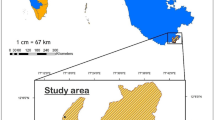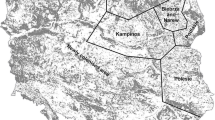Abstract
In the last decades, profound modifications of agricultural practices occurred in Europe, including the introduction of modern livestock farming. These modifications negatively affected the fauna of rural areas, as indicated by the large demographic declines suffered by several populations of birds typical of these habitats. The impact of agricultural practices on bird populations has been widely investigated, while the effect of livestock farming has seldom been assessed. To fill this gap, we carried out a quantitative meta-analysis of the existing scientific literature and evaluated the size of the effects of livestock farming on birds of rural areas in Europe. We only found 26 papers on this topic, from which 72 effect sizes could be estimated. The barn swallow (Hirundo rustica) was the species on which most studies focused. Livestock farming positively influenced presence and distribution of barn swallows in breeding habitats, while it did not significantly affect reproduction of this species. Effects on other bird species typical of rural habitats were non-significant. The positive effect on the insectivorous barn swallow might be mediated by the enhanced insect abundance where livestock is reared. In addition, habitat features typical of rural settings where livestock is reared (e.g. cattle-sheds or large hayfields) positively affected barn swallows independently of actual presence of livestock at a setting. Presence of livestock at rural setting therefore seems beneficial to barn swallows, but not significantly to other bird species typical of rural habitats. The effect of livestock farming on birds of rural habitats has been under-investigated to date.

Similar content being viewed by others
References
Ambrosini R, Saino N (2010) Environmental effects at two nested spatial scales on habitat choice and breeding performance of barn swallow. Evol Ecol 24:491–508
Ambrosini R, Bolzern A, Canova L, Arieni S, Møller AP, Saino N (2002a) The distribution and colony size of barn swallow in relation to agricultural land use. J Appl Ecol 39:524–534
Ambrosini R, Bolzen AM, Canova L, Saino N (2002b) Latency in the response of barn swallow Hirundo rustica population to changes in breeding habitat conditions. Ecol Lett 5:640–647
Ambrosini R, Rubolini D, Trovo P, Liberini G, Bandini M, Romano A, Sicurella B, Scandolara C, Romano M, Saino N (2012) Maintenance of livestock farming may buffer population decline of the Barn Swallow Hirundo rustica. Bird Conserv Int 22:411–428
Anderson GQA, Bradbury RB, Evans AD (2001) Evidence for the effects of agricultural intensification on wild bird populations in the UK. RSPB Research Report No 3, RSPB, Sandy
Begg CB, Mazumdar M (1994) Operating characteristics of a rank correlation test for publication bias. Biometrics 50:1088–1101
Benton TG, Vickery JA, Wilson JD (2003) Farmland biodiversity: is habitat heterogeneity the key? Trends Ecol Evol 18:182–188
Cohen J (1988) Statistical power analysis for the behavioral sciences, 2nd edn. Lawrence Erlbaum, Hillsdale
Donald PF, Green RE, Heath MF (2001) Agricultural intensification and the collapse of Europe’s farmland bird populations. Proc R Soc Lond B 268:25–29
Donald PF, Pisano G, Rayment MD, Pain DJ (2002) The common agricultural policy, EU enlargement and the conservation of Europe’s farmland birds. Agric Ecosyst Environ 89:167–182
Donald PF, Sanderson FJ, Burfield IJ, Van Bommel FPJ (2006) Further evidence of continent-wide impacts of agricultural intensification on European farmland birds 1990–2000. Agric Ecosyst Environ 116:189–196
Duval S, Tweedie R (2000) A non-parametric ‘trim and fill’ method of assessing publication bias in meta-analysis. J Am Stat Assoc 95:89–98
Eggers S, Unell M, Pärt T (2011) Autumn-sowing of cereals reduces breeding bird numbers in a heterogeneous agricultural landscape. Biol Conserv 144:1137–1144
Evans AD, Robinson RA (2004) Barn swallows and agriculture. Brit Birds 97:218–230
Evans KL, Bradbury RB, Wilson JD (2003) Selection of hedgerows by Swallows Hirundo rustica foraging on farmland: the influence of local habitat and weather. Bird Study 50:8–14
Evans DM, Redpath SM, Evans SA, Elston DM, Dennis P (2005) Livestock grazing affects the egg size of an insectivorous passerine. Biol Lett 1:322–325
Evans KL, Wilson JD, Bradbury RB (2007) Effects of crop type and aerial invertebrate abundance on foraging barn swallows Hirundo rustica. Agric Ecosyst Environ 122:267–273
Evans DM, Villar N, Littlewood NA, Pakeman RJ, Evans SA, Dennis P, Skartveit J, Redpath SM (2015) The cascading impacts of livestock grazing in upland ecosystems: a 10-year experiment. Ecosphere 6:42
Fisher RA (1928) Statistical methods for research workers, 2nd edn. Oliver and Boyd, London
Fragkos KC, Tsagris M, Frangos C (2014) Publication bias in meta-analysis: confidence intervals for Rosenthal’s fail-safe number. Int Sch Res Notices 2014:825383. doi:10.1155/2014/825383
Fuller RJ, Gregory RD, Gibbons DW, Marchant JH, Wilson JD, Baillie SR, Carter N (1995) Population declines and range contractions among lowland farmland birds in Britain. Conserv Biol 9:1425–1441
Geiger F, Bengtsson J, Berendse F, Weisser WW, Emmerson M, Morales MB, Ceryngier P, Liira J, Tscharntke T, Winqvist C, Eggers S, Bommarco R, Part T, Bretagnolle V, Plantegenest M, Clement LW, Dennis C, Palmer C, Onate JJ, Guerrero I, Hawro V, Aavik T, Thies C, Flohre A, Hanke S, Fischer C, Goedhart PW, Inchausti P (2010) Persistent negative effects of pesticides on biodiversity and biological control potential on European farmland. Basic Appl Ecol 11:97–105
Gillings S, Fuller RJ (1998) Changes in bird populations on sample lowland English farms in relation to loss of hedgerows and other non-crop habitats. Oecologia 116:120–127
Gregory RD, Strien A, van Vorisek P, Meyling AWG, Noble DG, Foppen RPB, Gibbons DW (2005) Developing indicators for European birds. Phil Trans R Soc B 360:269–288
Grüebler MU, Korner-Nievergelt F, Von Hirsch J (2010) The reproductive benefits of livestock farming in Barn swallows Hirundo rustica: quality of nest site or foraging habitat? J Appl Ecol 47:1340–1347
Harrison C (1988) A history of the birds of Britain. Collins, London
Hart JD, Milsom TP, Baxter A, Kelly PF, Parkin WK (2002) The impact of livestock on Lapwing Vanellus vanellus breeding densities and performance on coastal grazing marsh: even at very low stocking densities, livestock reduced breeding densities of adult Lapwings and increase the risk of nest loss due to predation. Bird Study 49:67–78
Henderson I, Holt C, Vickery J (2007) National and regional patterns of habitat association with foraging barn swallows Hirundo rustica in the UK. Bird Study 54:371–377
Hiron B, Berg A, Eggers S, Josefsson J, Pärt T (2013) Bird diversity relates to agri-environment schemes at local and landscape level in intensive farmland. Agric Ecosyst Environ 176:9–16
Kleijn D, Sutherland WJ (2003) How effective are European agri-environment schemes in conserving and promoting biodiversity? J Appl Ecol 40:947–969
Kragten S, Reinstra E, Gertenaar E (2009) Breeding barn swallows Hirundo rustica on organic and conventional arable farms in the Netherlands. J Ornithol 150:515–518
Lefranc N (1997) Shrikes and the farmed landscape in France. In: Pain DJ, Pienkowski MW (eds) Farming and birds in Europe: the common agricultural policy and its implications for bird conservation. Academic Press, London, pp 236–268
Lubbe SK, de Snoo GR (2007) Effect of dairy farm management on Swallow Hirundo rustica abundance in The Netherlands. Bird Study 54:176–181
McMahon BJ, Heldena H, Anderson A, Sheridana H, Kinsella A, Purvis G (2010) Interactions between livestock systems and biodiversity in South-East Ireland. Agric Ecosyst Environ 139:232–238
Meyer WB, Turner BL II (1992) Human population growth and global land-use/cover change. Annu Rev Ecol Syst 23:39–61
Møller AP (1983) Breeding habitat selection in the Swallow Hirundo rustica. Bird Study 30:134–142
Møller AP (2001) The effect of dairy farming on barn swallow Hirundo rustica abundance, distribution and reproduction. J Appl Ecol 6:378–389
Møller AP, Nielsen JT (1997) Differential predation cost of a secondary sexual character: sparrowhawk predation on barn swallows. Anim Behav 54:1545–1551
Møller AP, Jennions MD (2001) Testing and adjusting for publication bias. Trends Ecol Evol 16:580–586
Newton I (2004) The recent declines of farmland bird populations in Britain: an appraisal of causal factors and conservation actions. Ibis 146:579–600
Orłowski G, Karg J (2011) Diet of nestling barn swallows Hirundo rustica in rural areas of Poland. Cent Eur J Biol 6:1025–1035
Orłowski G, Karg J (2013) Partitioning the effect of livestock farming on the diet of an aerial insectivorous passerine, the barn swallow Hirundo rustica. Bird Study 60:111–123
Pavel C (2004) The impact of grazing animals on nesting success of grassland passerines in farmland and natural habitats: a field experiment. Folia Zool 53(171):178
PECBMS (2015) http://www.ebcc.info/index.php?ID=588. Accessed on 1 Nov 2015
R Core Team (2014) R: a language and environment for statistical computing. R Foundation for Statistical Computing, Vienna
Robinson RA, Sutherland WJ (2002) Post-war changes in arable farming and biodiversity in Great Britain. J Appl Ecol 39:157–176
Rosenthal R (1979) The ‘‘file drawer problem’’ and tolerance for null results. Psychol Bull 86:638–641
Rosenthal R (1991) Meta-analytic procedures for social research. Russell Sage Foundation, New York
Rosenthal R (1994) Parametric measures of effect size. In: Cooper H, Hedges LV (eds) The handbook of research synthesis. Russell Sage Foundation, New York, pp 231–244
Sicurella B, Caprioli M, Romano A, Romano M, Rubolini D, Saino N, Ambrosini R (2014) Hayfields enhance colony size of the barn swallow Hirundo rustica in northern Italy. Bird Conserv Int 24:17–31
Song F, Eastwood AJ, Gilbody S, Duley L, Sutton AJ (2000) Publication and related biases. Health Technol Asses 4:1–115
Tucker G (1997) Priorities for bird conservation in Europe: the importance of the farmed landscape. In: Pain DJ, Pienkowski MW (eds) Farming and birds in Europe: the common agricultural policy and its implications for bird conservation. Academic Press, London, pp 79–116
Turner AK (2006) The barn swallow. T and AD Poyser, London
Van den Brink B (2003) Hygienemaatregelen op moderne boerenbedrijven en het lot van Boerenzwaluwen Hirundo rustica. Limosa 76:109–116
Van den Noortgate W, López-López JA, Marín-Martínez F, Sánchez-Meca J (2013) Three-level meta-analysis of dependent effect sizes. Behav Res 45:576–594
Vickery JA, Tallowin JR, Feber RE, Asteraki EJ, Atkinson PW, Fuller RJ, Brown VK (2001) The management of lowland neutral grasslands in Britain: effects of agricultural practices on birds and their food resources. J Appl Ecol 38:647–664
Viechtbauer W (2010) Conducting meta-analyses in R with the metafor package. J Stat Softw 36(3):1–48
Von Post M, Smith H (2015) Effects on rural house sparrow and tree sparrow populations by experimental nest-site addition. J Ornithol 156:231–237
Willi T, Körner-Nievergelt F, Grüebler MU (2011) Rauchschwalben Hirundo rustica brauchen Nutztiere, Mehlschwalben Delichon urbicum Nisthilfen. Orn Beob 108:215–224
Acknowledgments
We are grateful to Prof. Wim Van den Noortgate for advices on meta-analytic mixed models. Grzegorz Orłowski kindly provided additional information on sign of effect sizes not reported in original papers. Comments by Dan Chamberlain and an anonymous reviewer greatly improved the quality of the paper. This research was funded by grant 2014-ATE-0437 to RA.
Author information
Authors and Affiliations
Corresponding author
Additional information
Communicated by Karen E. Hodges.
Electronic supplementary material
Below is the link to the electronic supplementary material.
Rights and permissions
About this article
Cite this article
Musitelli, F., Romano, A., Møller, A.P. et al. Effects of livestock farming on birds of rural areas in Europe. Biodivers Conserv 25, 615–631 (2016). https://doi.org/10.1007/s10531-016-1087-9
Received:
Revised:
Accepted:
Published:
Issue Date:
DOI: https://doi.org/10.1007/s10531-016-1087-9




